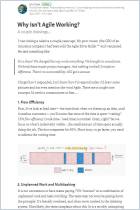Зарегистрируйтесь на getAbstract, чтобы получить доступ к этому краткому изложению.

Зарегистрируйтесь на getAbstract, чтобы получить доступ к этому краткому изложению.
Knowledge@Wharton
Has Agile Management’s Moment Arrived?
Knowledge@Wharton, 2017
Что внутри?
Move over, gig economy. Agile management needs its home-based workers back.
Recommendation
The gig economy offers flexible working conditions and freelance opportunities to people and provides companies with outsourcing options. What it lacks though, is the convenience of being able to turn to a teammate and thrash out an idea together. Now companies want that kind of collaboration back. As more companies outside of software development adopt the agile approach to management, they may whistle back their home-based employees to strengthen the bonds among team members and reinforce the connection between employees and the company. Knowledge@Wharton – the online business analysis journal of the Wharton School of the University of Pennsylvania – explains what agile management is, why it’s becoming popular and why it may require a complete overhaul of your organizational structure. getAbstract recommends this insightful article to agile management novices.
Summary
About the Author
Knowledge@Wharton is the online business analysis journal of the Wharton School of the University of Pennsylvania.



















Comment on this summary